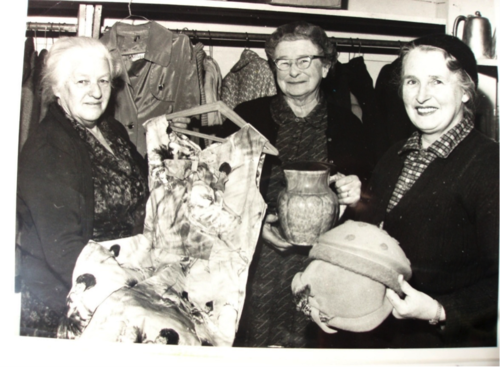In 1949, parents of children with impairments, including intellectual disability, founded the forerunner to the IHC external, called the Intellectually Disabled Children’s Parents’ Association.
They wanted schools and community facilities for their children so they could keep them at home and out of institutions, as recommended by the World Health Organisation.
At that time there were few disability support organisations. One was the Wellington After Care Association – but its support was limited.

IHC women fundraising 1960s Turnbull Library PA Coll 9653
The parental advocates faced much discrimination. In Wellington, Oriental Bay residents petitioned against their planned school.
The local MP, Peter Fraser, instead found them temporary space in the stand at the Basin Reserve and they eventually built their own preschool and centre in Newtown.
Over the decades IHC nurtured the establishment of numerous disability organisations such as Autism NZ, Parent to Parent and the Down Syndrome Association.
Although parents lobbied the new government for direct support, the Government instead set up a Consultative Committee under Dr Aitken of the Otago Medical School, who was also the father of a disabled daughter.
The Committee recommended expansion of the current psychopaedic institutions – including Templeton, Kimberley, Braemar and Mangere — into large ‘mental deficiency colonies’ with parents encouraged to send their children there by five years old.
This resulted in a huge expansion in institutionalisation over the next two decades, despite another report in 1959 by Dr Burns of the British Medical Association supporting the parents’ calls for community facilities and services.
As a result of the Aitken report the institutions were extended and numbers of residents rapidly increased.
A 1964 documentary estimated that one in a thousand children had an impairment which required their institutionalisation.
Smaller units were attached to some local public hospitals, while other children ended up in adult psychiatric hospitals.
To deal with these growing numbers the new profession of specialist psychopaedic nurse was developed in New Zealand with in-house training. The first cohort graduated in 1964.
Concerns about institutionalisation had been growing since the 1940s.
In 1973, a Royal Commission on psychopaedic hospitals recommended transference from large institutions to community care, and led to three decades of deinstitutionalisation, during which the Government had to pay for both community care and upkeep for the large institutions.
At its height, an estimated 2% of the population was institutionalised with more than 800 people at Kimberley. By 1978, the occupancy rate was 0.24%, the lowest since 1881.
In 2007, the Confidential Forum for Former In-Patients of Psychiatric Hospitals external heard stories about the ‘back wards’ of the institutions as places of horror and threat, of adults and children living together in distressing conditions.
Sir Robert Martin external’s biography, Becoming a person, provides valuable insights into institutionalisation. Soon after his birth in 1957, he was labelled ‘retarded’ and placed in Kimberley Hospital and Training Centre near Levin.
He also experienced Otekaike/Campbell Park residential school in North Otago, violent and abusive foster care, and the notorious Lake Alice Hospital in rural Rangitikei.
Numerous reports of abuse at Lake Alice eventually emerged. Like many other institutions it was isolated in a rural area, far from nurturing community.
The doctor in charge created a climate of sadism and fear that the young people, mainly boys, could not escape. As disability advocate, Sir Robert Martin, often says, “How can humans treat other humans like that?”
Although the deinstitutionalisation movement started in the 1970s it took until 2006 and a march on Parliament for the last one, Kimberley, to close.
Sir Robert warned:
Though it’s great that New Zealand closed its last institution, being institutionalised is not just about the buildings - the bricks and mortar - it’s also about values, beliefs, actions and activities. It’s about the way things are done, the decisions that are made, who makes them and who has the control.
In New Zealand we still need to work hard to ensure that people with disabilities do not continue to be institutionalised even though they live in community settings. (People First, 2010:9)